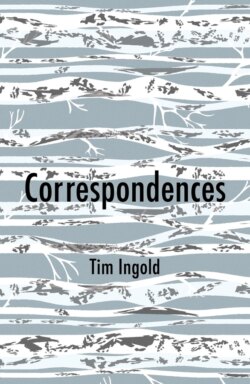Читать книгу Correspondences - Tim Ingold - Страница 9
Being and becoming
ОглавлениеOnly when we appreciate things as their stories can we begin to correspond with them. So you, the reader, should practise this way of seeing before embarking upon the following essays. We are so used to taking a rearward view, to capturing things a moment too late, when they have already settled into the shapes and categories assigned to them. As in the game of grandmother’s footsteps, the world creeps up on us behind our backs, but freezes on the instant when we turn around to look. To correspond we need to go behind the scenes, to join with the creepers and to move along with them in real time. Immediately upon doing so, what grandmother sees only as statues come vibrantly to life. The statue is already cast, but the creepers are alive in the casting. Theirs is a stance not of being but of becoming. Corresponding with them calls for a shift, as philosophers would say, from ontology to ontogeny. Ontology is about what it takes for a thing to exist, but ontogeny is about how it is generated, about its growth and formation. This shift, moreover, has important ethical implications. For it suggests that things are far from closed to one another, each wrapped up in its own, ultimately impenetrable world of being. On the contrary, they are fundamentally open, and all participate in one indivisible world of becoming. Multiple ontologies signify multiple worlds, but multiple ontogenies signify one world. Since, in their growth or movement, the things of this world respond to one another, they are also responsible. And in this one world of ours, responsibility is not for some but not others. It is a burden that all must carry.
Now there are some who can only comprehend a way of thinking by first assigning it to a school of thought. And from what I’ve said so far, they would probably guess that I was schooled in phenomenology. It’s perfectly true that I have been influenced by thinkers identified with this tradition. Yet phenomenology has not, for me, been a point of departure. I have never thought of it as an approach or way of working that I might first absorb and then apply. Like most things philosophical, it has grown on me more or less serendipitously, and has wormed its way into my thinking without my really noticing it. No doubt, this home-grown phenomenology of mine takes all kinds of liberties with the canonical texts, many of which I am happy to leave unread. Textual exegesis is a task for trained philosophers, and not for amateurs like me. I have always been slightly bemused by scholars who bury their heads in the most arcane and impenetrable of texts in the effort, they tell us, to get to the bottom of our experience as beings in a world. You would think that the best way to fathom the depths of human experience would be to attend to the world itself, and to learn directly from what it has to tell us. This is what inhabitants do all the time, in their daily lives, and we have much to learn from them. That’s why I continue to insist that if we are even to begin to resolve the crisis in our habitation of the world, then we should listen to the wisdom of inhabitants, whether they be humans or beings of other kinds, rather than taking shelter in the closeted self-referentiality of philosophical discourse.
If, today, our world is in crisis, it is because we have forgotten how to correspond. We have engaged, instead, in campaigns of interaction. Parties to interaction face each other with their identities and objectives already in place, and transact in ways that serve, but do nothing to transform, their separate interests. Their difference is given from the start, and remains afterwards. Interaction is thus a between relation. Correspondence, however, goes along. The trouble is that we have been so wrapped up in our interactions with others that we have failed to notice how both we and they go along together in the current of time. As I’ve tried to show, correspondence is about the ways along which lives, in their perpetual unfolding or becoming, simultaneously join together and differentiate themselves, one from another. This shift from interaction to correspondence entails a fundamental reorientation, from the between-ness of beings and things to their in-between-ness.3 Think of a river and its banks. We might speak of the relation of one bank to the other and, crossing a bridge, we might find ourselves halfway between the two. But the banks are perpetually forming and re-forming as the river waters sweep by. These waters flow in-between the banks, in a direction orthogonal to the span of the bridge. To say of beings and things that they are in-between is to align our awareness with the waters; to correspond with them is to join this awareness with the flow. Just such a shift of orientation is needed, I believe, if we are to understand the world as one that we can inhabit both now and for the foreseeable future. It is, in short, a condition for sustainable living.
